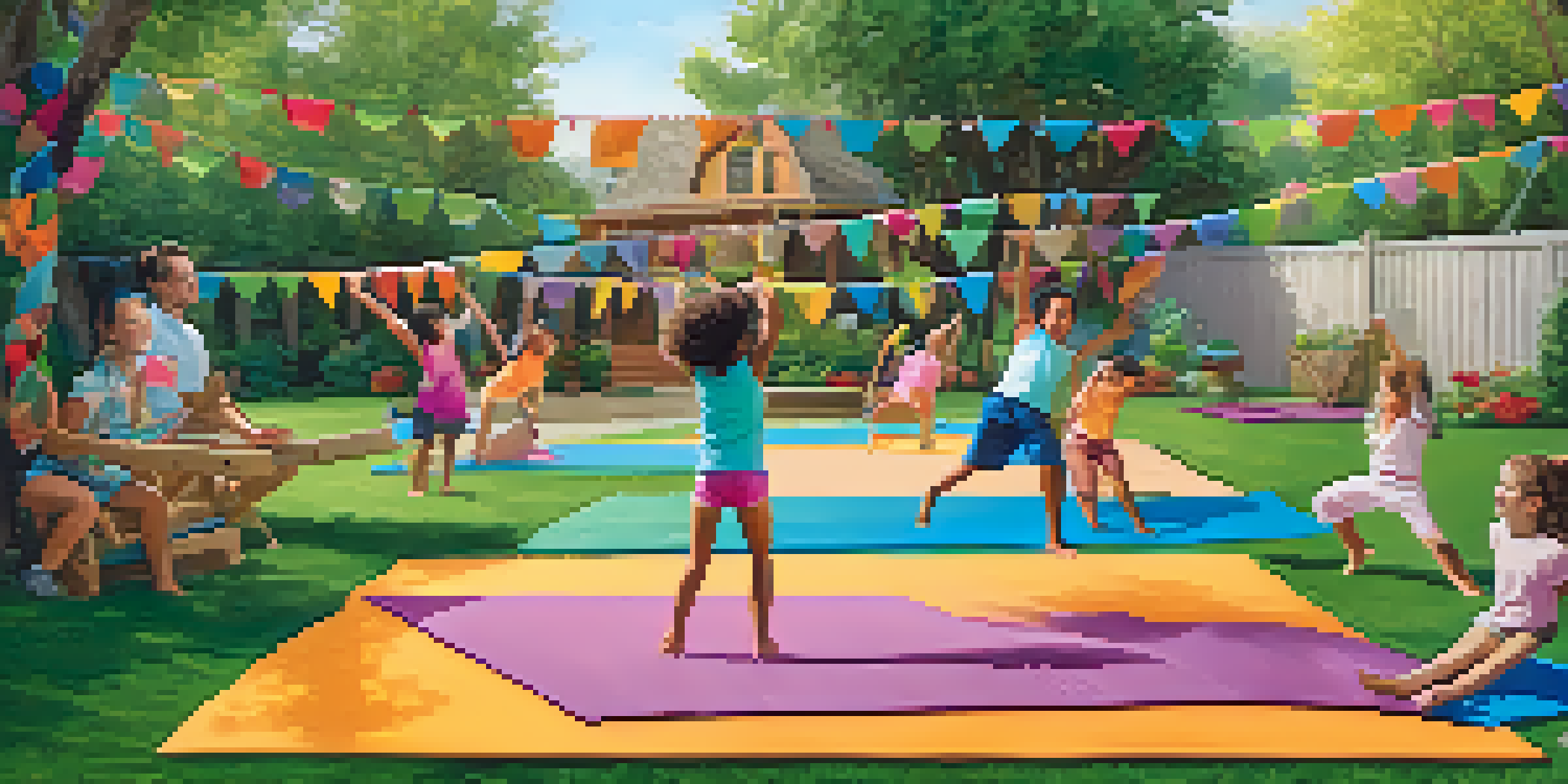Engaging Kids in Yoga: Fun Techniques for Family Sessions

Why Yoga is Great for Kids and Families
Yoga offers numerous benefits for children, including improved flexibility, strength, and balance. It's also a fantastic way to help them manage stress and anxiety, which is increasingly important in today's fast-paced world. When families practice yoga together, they not only strengthen their bodies but also their bonds.
Yoga is the journey of the self, through the self, to the self.
Engaging in yoga as a family creates a shared experience that fosters communication and teamwork. Kids learn the importance of mindfulness and can express their emotions in a healthy way. Plus, it’s a fun way to create lasting memories and traditions.
Ultimately, yoga promotes a sense of well-being in children and families alike, helping everyone to feel more connected and relaxed. When kids learn these skills early on, they carry them throughout life, creating a positive ripple effect.
Creating a Fun Atmosphere for Family Yoga
To engage kids in yoga, start by creating a fun and inviting atmosphere. Set up a cozy space with colorful mats, soft lighting, and calming music to make the experience enjoyable. Let the kids help in choosing the music or decorating the space; their involvement sparks enthusiasm.

Using props like stuffed animals or colorful blocks can make yoga poses more relatable and playful. For example, kids can use a teddy bear to practice the 'Tree Pose' by balancing it on their heads. This not only makes the practice more fun but also encourages creativity.
Yoga Enhances Family Connections
Practicing yoga together helps families strengthen their bonds while improving communication and teamwork.
Don't forget to incorporate some laughter! Silly poses or funny names for stretches can lighten the mood and keep everyone engaged. The goal is to create a joyful experience that kids look forward to rather than a chore.
Incorporating Games into Yoga Sessions
Transform yoga into a game to capture the kids' attention. Incorporate elements like freeze yoga, where participants hold poses until the music stops, or yoga charades, where they act out animals or objects while others guess the pose. This playful approach keeps everyone active and entertained.
In the midst of movement and chaos, keep stillness inside of you.
You can also create a yoga obstacle course using pillows, mats, and other household items. Kids can navigate the course by performing specific poses at each station, adding an element of adventure to their practice. This not only makes yoga physical but also imaginative.
Games help children learn yoga poses while having fun, reinforcing the idea that exercise can be enjoyable. Plus, this interactive format encourages teamwork and cooperation among family members.
Using Stories to Teach Yoga Poses
Storytelling can be a powerful tool to engage kids in yoga. Create a narrative that incorporates various yoga poses, allowing children to act out the story through movement. For instance, a journey through a jungle can include poses like the 'Cobra' and 'Monkey' as they mimic the animals along the way.
This approach not only captures their imagination but also helps with memory retention. Children are more likely to remember poses when they associate them with a story or adventure. You might find them naturally recalling these poses during playtime.
Make Yoga Fun for Kids
Incorporating games, props, and storytelling into yoga sessions makes the practice enjoyable and engaging for children.
Additionally, storytelling fosters a sense of connection and creativity. Kids can even create their own stories and poses, making the practice uniquely theirs and encouraging self-expression.
Mindfulness and Breathing Techniques for Kids
Teaching kids about mindfulness and breathing can enhance their yoga experience. Simple breathing exercises, like 'balloon breathing,' where they imagine inflating a balloon with each inhale, can help them focus and calm their minds. This practice is not only beneficial during yoga but also in everyday life.
Encourage kids to use their senses during these exercises. Ask them to close their eyes and identify sounds or smells around them, promoting awareness of their environment. This connection to the present moment can be grounding, especially for active children.
By integrating mindfulness into yoga, kids learn to manage their emotions and stress in a healthy way. These skills are invaluable as they grow, providing tools to navigate challenges both on and off the mat.
Choosing the Right Yoga Styles for Kids
Not all yoga styles are created equal, especially when it comes to engaging kids. Look for classes or resources that focus on playful, dynamic styles like children's yoga or restorative yoga. These types often incorporate games, storytelling, and creativity to keep young minds interested.
Additionally, consider adapting traditional poses into more kid-friendly versions. For example, the 'Downward Dog' can become 'Puppy Pose,' allowing kids to connect with their inner animal while practicing their poses. This makes yoga relatable and enjoyable for them.
Consistency Builds Yoga Skills
Establishing a regular yoga routine fosters familiarity with poses and promotes overall well-being in kids.
Experiment with various styles to see which resonates best with your family. Adapting the yoga experience to suit their interests will keep them motivated and eager to participate.
The Importance of Consistency and Routine
Establishing a regular yoga routine can significantly enhance the benefits for kids. Consistency helps them become familiar with poses and breathing techniques, allowing them to grow more comfortable and confident in their practice. Consider setting aside specific times each week for family yoga sessions.
Incorporating yoga into daily routines, like morning stretches or bedtime wind-downs, can also create a sense of normalcy. This makes it easier for kids to integrate mindfulness into their lives, promoting overall well-being.

Remember, the key is to keep it light and flexible. If kids miss a session or need a break, it’s important to approach it with understanding. The goal is to cultivate a love for yoga, not to create pressure.
Tracking Progress and Celebrating Achievements
Tracking progress can be a fun way to keep kids motivated and engaged in their yoga practice. Consider using a sticker chart or journal where they can log their poses, feelings, or milestones. This visual representation of their journey can boost their confidence and encourage them to continue.
Celebrating achievements, no matter how small, is equally important. Whether it's mastering a new pose or simply showing up for a session, recognition fosters a sense of accomplishment. You can celebrate with a family yoga party or a special treat to honor their efforts.
By focusing on progress and celebration, you create a positive reinforcement loop that encourages kids to keep practicing. This approach instills a lifelong appreciation for yoga, health, and well-being.